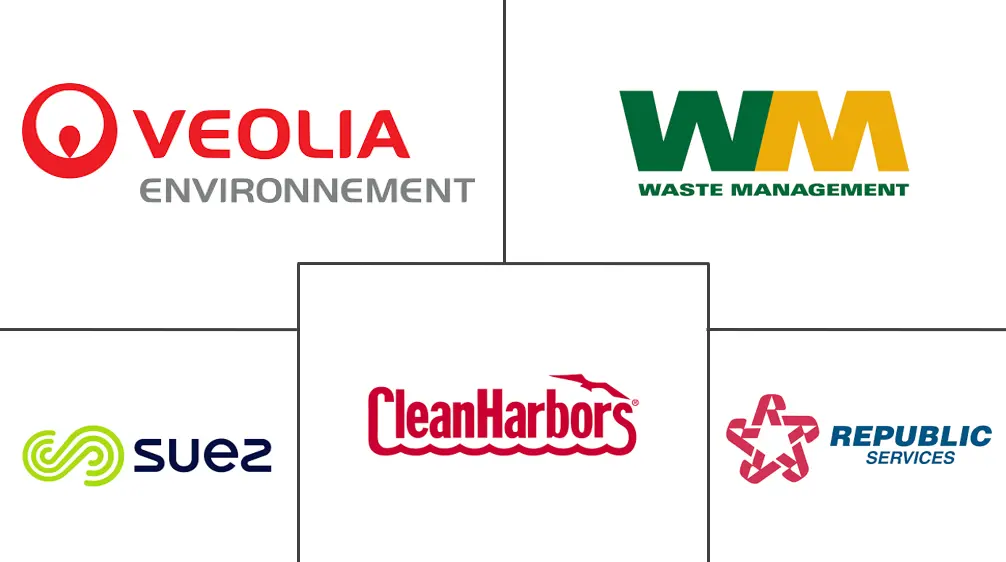Hazardous Waste Management Market Size and Share

Hazardous Waste Management Market Analysis by Mordor Intelligence
The Hazardous Waste Management Market size is estimated at USD 52.94 billion in 2025, and is expected to reach USD 72.66 billion by 2030, at a CAGR of 6.54% during the forecast period (2025-2030). Stricter global regulations, notably the Basel Convention’s 2024-2025 work programme and the European Union’s May 2024 Waste Shipments Regulation, are heightening compliance costs while opening new service opportunities.[1][2]Basel Convention Secretariat, “Basel Convention 2024-2025 Work Programme,” basel.int European Commission, “Regulation (EU) 2024” environment.ec.europa.euTechnology is reshaping competitive dynamics: supercritical water oxidation now achieves 99.99% PFAS destruction, and blockchain-enabled tracking systems cut collection-route emissions by 30%. Asia-Pacific’s 40.24% revenue share, supported by China’s QR-coded chemical inventory scheme, underlines the region’s dominance and the escalating need for sophisticated treatment capacity. Meanwhile, oil-and-gas decommissioning in the Middle East enlarges offshore waste volumes, and North America’s circular-economy funding is pivoting disposal models toward resource recovery.[3]Basel Convention Secretariat, “Basel Convention 2024-2025 Work Programme,” basel.int European Commission, “Regulation (EU) 2024” environment.ec.europa.eu
Key Report Takeaways
- By physical state, liquid waste held 42% of the hazardous waste management market share in 2024; sludge is advancing at a 6.8% CAGR through 2030.
- By waste category, chemical waste led with 41% revenue share in 2024, whereas biomedical waste posts the fastest 8.7% CAGR to 2030.
- By treatment method, thermal technologies commanded a 40% share in 2024; recycling and resource recovery expanded at a 10.9% CAGR.
- By service, collection and transportation contributed a 32% share in 2024, while consulting, audit, and training services grew at an 8.9% CAGR.
- By industry, oil and gas accounted for 26% of the hazardous waste management market size in 2024; electronics and e-waste recycling are projected to rise at a 10.3% CAGR.
- By geography, Asia-Pacific captured 40.24% market share in 2024 and is also the fastest-growing region at 6.8% CAGR.
Global Hazardous Waste Management Market Trends and Insights
Drivers Impact Analysis
| Driver | (~) % Impact on CAGR Forecast | Geographic Relevance | Impact Timeline |
|---|---|---|---|
| Stringent compliance pressure from Basel, Stockholm & Minamata-aligned national regulations | +1.8% | Global, strongest in EU & North America | Medium term (2-4 years) |
| Rapid growth of complex waste streams from battery, PV & EV manufacturing in Asia | +1.2% | APAC core, global supply chains | Long term (≥ 4 years) |
| Surging cross-border waste trade creating demand for traceability solutions in Europe | +0.9% | Europe & trade partners | Short term (≤ 2 years) |
| Rise of circular-economy targets driving hazardous waste-to-resource projects in North America | +0.7% | North America & EU | Medium term (2-4 years) |
| Oil & gas well-decommissioning wave boosting offshore hazardous volumes in Middle East | +0.6% | Middle East, North Sea, Gulf of Mexico | Long term (≥ 4 years) |
| Source: Mordor Intelligence | |||
Stringent Compliance Pressure from Basel, Stockholm & Minamata-aligned National Regulations
National laws are tightening in step with multilateral treaties. The Basel Convention’s latest program enhances reporting and enforcement, while Hong Kong’s 2025 e-waste controls require prior consent for all transboundary shipments.[4]Basel Convention Secretariat, “Basel Convention 2024-2025 Work Programme,” basel.int European Commission, “Regulation (EU) 2024” environment.ec.europa.eu The EU’s Waste Shipments Regulation adds mandatory digital tracking by 2026, escalating demand for audit, consulting, and advanced tracking platforms. Corporations are harmonizing global policies to pre-empt penalties, and this harmonization translates into multi-region service contracts that enlarge the hazardous waste management market. Providers with compliance expertise are therefore winning long-term engagements.
Rapid Growth of Complex Waste Streams from Battery, PV & EV-Manufacturing in Asia
China’s soaring lithium-ion battery output and India’s 100.33 GW solar milestone are flooding the region with end-of-life batteries and panels, each governed by hazardous-goods transport rules. ASEAN’s projection of up to 2,166 GWh of reusable batteries by 2040 underscores the scale of incoming waste. Advanced separation technologies and joint ventures, such as Indonesia’s partnerships with foreign firms for EV battery recycling, signal fresh revenue channels. As treatment sophistication rises, Asia-Pacific cements its central role in the hazardous waste management market.
Surging Cross-Border Waste Trade Creating Demand for Traceability Solutions in Europe
Europe is digitising waste logistics under the Digital Product Passport, obligating cradle-to-grave tracking by 2026. OECD guidelines promote real-time analytics to curb illegal shipments, supporting rapid adoption of blockchain and IoT platforms. Early pilots show 30% route-emission cuts and fewer mis-classified cargos. These systems generate new licensing opportunities for technology firms, though compliance costs rise for waste producers, especially SMEs.
Rise of Circular-Economy Targets Driving Hazardous Waste-to-Resource Projects in North America
Veolia’s USD 1 billion Arkansas investment introduces high-temperature treatment paired with energy recovery, mirroring federal Superfund and Brownfield allocations totalling USD 5 billion that prioritise resource capture over disposal.[5]Hong Kong Environmental Protection Department, “Implementation of Basel E-waste Amendments,” epd.gov.hk Corporate roadmaps, such as Sanofi’s 90% reuse target, illustrate how industrial clients are recasting procurement toward recyclable materials. Service providers securing circular-economy credentials are experiencing higher contract renewal rates, bolstering their foothold in the hazardous waste management market.
Restraints Impact Analysis
| Restraint | (~) % Impact on CAGR Forecast | Geographic Relevance | Impact Timeline |
|---|---|---|---|
| High CAPEX requirements for advanced plasma & supercritical oxidation facilities | -1.4% | Global, steepest in developing regions | Medium term (2-4 years) |
| Fragmented generator base increases collection & logistics complexity in Africa | -0.8% | Africa, spill-over to Latin America & SE Asia | Long term (≥ 4 years) |
| Source: Mordor Intelligence | |||
High CAPEX Requirements for Advanced Plasma & Supercritical Oxidation Facilities
Equipment for supercritical water oxidation must endure extreme temperature and pressure, pushing project costs beyond the reach of many emerging-market operators. With only five commercial plasma units worldwide, long payback periods stall financing. Capital scarcity tilts capacity towards developed markets, inflating export and haulage fees for remote generators and slightly tempering growth in the hazardous waste management market.
Fragmented Generator Base Increases Collection & Logistics Complexity in Africa
Small, dispersed generators complicate routing, inflate per-unit costs, and lead to under-collection, as seen in Rwanda’s five-year national plan that still faces coordination shortfalls. Limited enforcement and inconsistent classification standards add regulatory risk for foreign entrants. These inefficiencies depress service margins and slow infrastructure deployment, capping regional contributions to overall market growth.
Segment Analysis
By Physical State: Liquid Dominance Drives Infrastructure Investment
Liquid hazardous waste accounted for 42% of the hazardous waste management market share in 2024, reflecting high solvent use in pharmaceutical, petrochemical, and electronics production. Its mobility, toxicity, and groundwater-contamination risk oblige strict containment and specialised logistics. Supercritical water oxidation, now piloted at the Orange County Sanitation District, promises near-total organic destruction while shrinking disposal volumes.
Sludge is the fastest-rising physical state, growing at a 6.8% CAGR to 2030. PFAS-laden biosolids and refinery residuals drive this trend, and 374Water’s AirSCWO unit can cut wet-sludge mass by 90% while generating clean effluent. Investment is flowing into dewatering, pre-treatment, and advanced oxidation, enhancing capacity utilisation across regional plants and deepening revenue resilience for the hazardous waste management market.
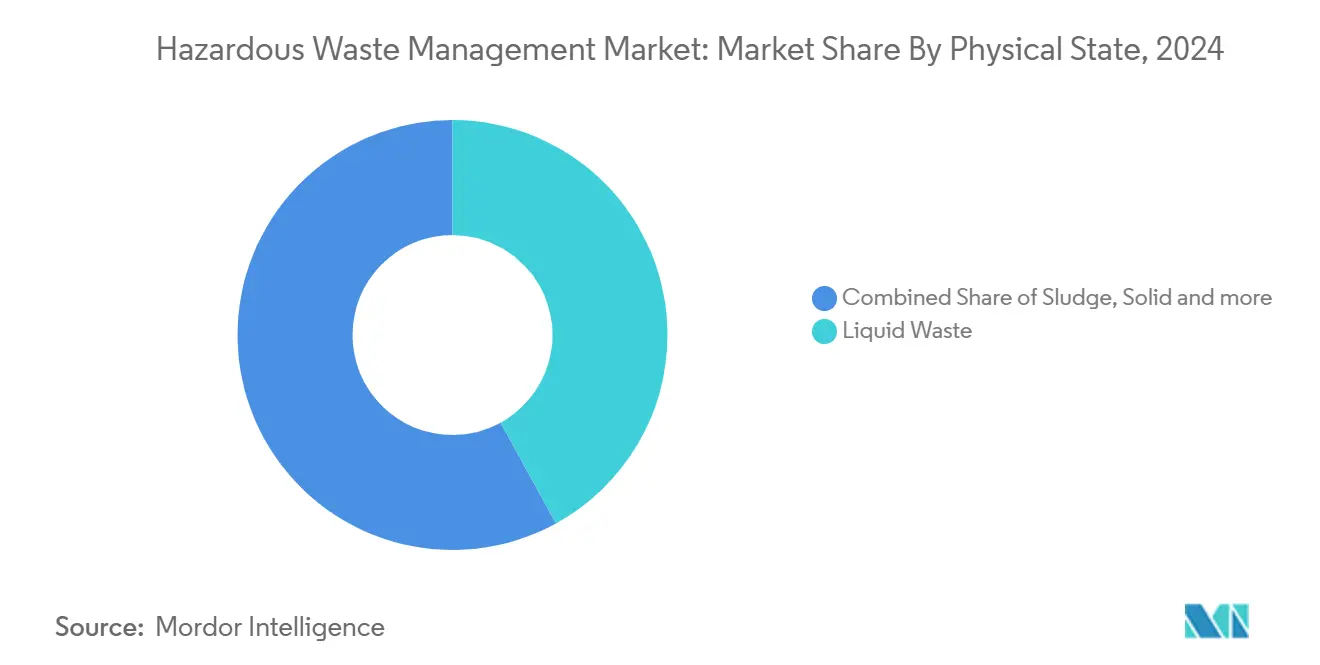
Note: Segment shares of all individual segments available upon report purchase
By Waste Category: Chemical Waste Leadership Faces Biomedical Challenge
Chemical waste retained a 41% share in 2024, underpinned by global chemicals output and stringent regulations for corrosive or reactive residues. Mature incineration and physico-chemical treatment capacity anchor this segment, but circular-economy mandates are pressuring producers to design out toxic inputs.
Biomedical waste posts the highest 8.7% CAGR, spurred by expanding healthcare capacity and post-pandemic infection-control protocols. Plasma gasification trials achieved 70.6% carbon conversion for medical plastics, offering a route to lower dioxin emissions. Firms that add medical-waste lines are diversifying revenue and elevating their profile in the hazardous waste management market.
By Treatment Method: Thermal Methods Lead While Recycling Accelerates
Thermal processes, including incineration and plasma arc, held a 40% revenue share in 2024. Their ability to deliver 99.99% destruction efficiency for mixed streams makes them indispensable, especially for infectious or POP-laden waste. Nonetheless, recycling and resource recovery outpace all sub-segments at a 10.9% CAGR through 2030, buoyed by EU and US producer-responsibility laws.
Veolia’s GreenUp strategy targets treatment of 9 million tonnes by 2027 with higher energy-capture ratios, signalling that incumbents see resource recovery as essential. Advances in plasma gasification yield syngas suitable for onsite energy, trimming operating costs, and bolstering returns. This dual focus stabilises revenues and sustains capacity additions in the hazardous waste management market.
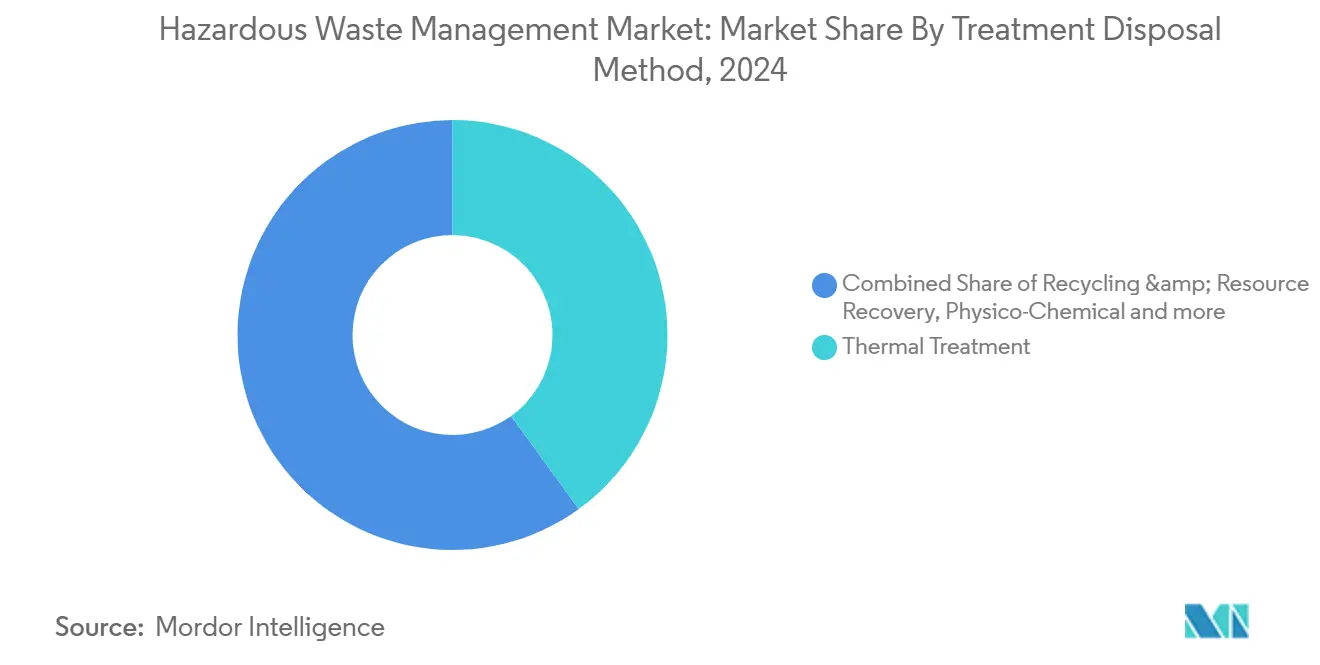
Note: Segment shares of all individual segments available upon report purchase
By Service: Collection Networks Enable Treatment Innovation
Collection and transportation services delivered 32% of revenue in 2024, underpinning every downstream activity. Complex ADR and DOT regulations limit new entrants and secure pricing power for compliant fleets. Artificial-intelligence route tools and IoT-enabled drums now reduce empty miles and shrink CO₂ output by 30%.
Consulting, audit, and training are the fastest-growing service lines at 8.9% CAGR, as companies grapple with multi-jurisdiction reporting, digital passports, and ESG disclosures. The EPA has trained over 14,100 environmental workers since 2023, signalling chronic skill gaps. Specialist advisory divisions therefore enjoy higher margins and deepen client stickiness across the hazardous waste management market.
By Industry: Oil & Gas Decommissioning Drives Electronics Growth
Oil and gas retained 26% of the hazardous waste management market size in 2024 on the back of drilling wastes, produced water sludge, and major decommissioning budgets. Veolia’s 70,000 t Middle East facility addresses precisely these outputs. Rig-to-reef programmes and waste-hierarchy policies are tilting processing toward recovery and reuse.
Electronics and e-waste recycling grow quickest at 10.3% CAGR, reflecting 62 billion kg of global e-waste in 2022, only 22.3% of which was properly treated. Advanced hydrometallurgical lines recovering cobalt, nickel, and rare earths are proliferating, creating high-margin niches within the hazardous waste management market.
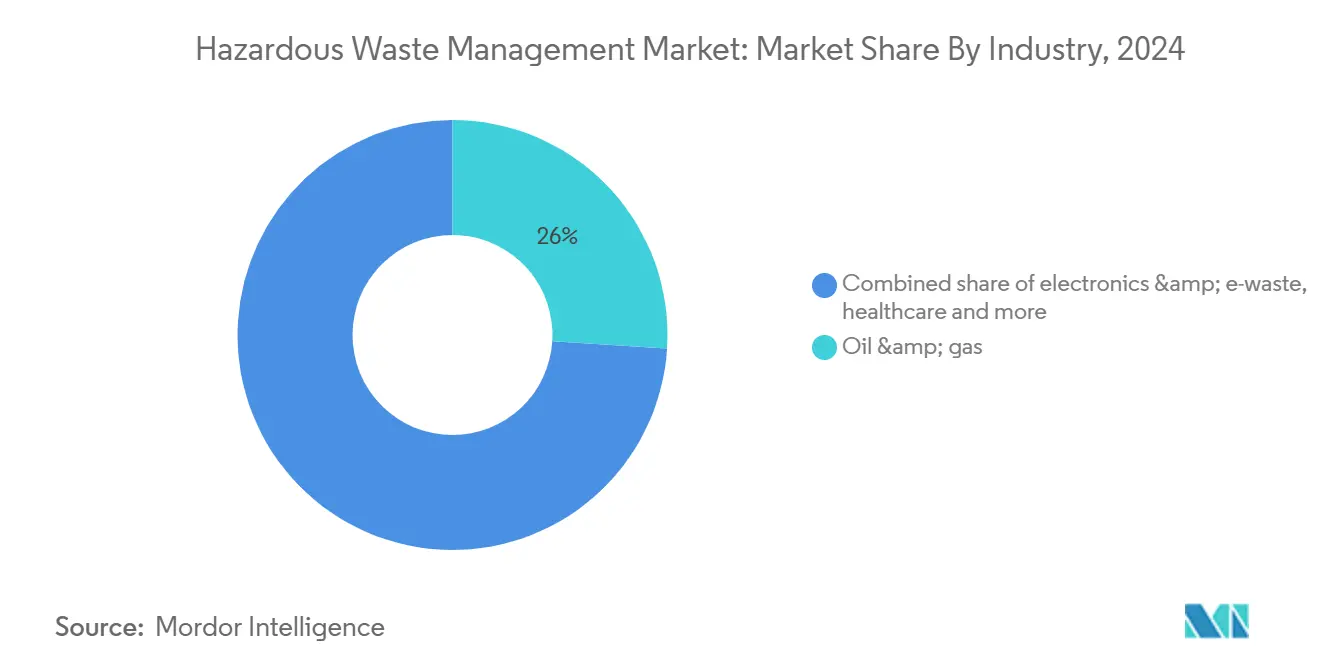
Note: Segment shares of all individual segments available upon report purchase
Geography Analysis
Asia-Pacific captured 40.24% of 2024 revenue and is forecast to grow at 6.8% CAGR to 2030, driven by electronics and battery manufacturing expansion, stringent Chinese QR-code chemical tracking, and India’s solar-panel recycling initiatives. Regional policies such as ASEAN’s framework for battery reuse and Japan’s projected 7.18-million-ton photovoltaic waste stream underline looming capacity needs. Investment is clustering in coastal industrial zones where integrated parks combine advanced incineration, resource recovery, and data-driven logistics, reinforcing Asia-Pacific’s centrality to the hazardous waste management market.
North America and Europe contribute stable, high-value streams under mature regulations. The United States’ Infrastructure Investment and Jobs Act channels USD 3.5 billion to Superfund sites and USD 1.5 billion to Brownfields, pivoting focus from disposal toward reclamation. Europe’s Waste Shipments Regulation introduces continent-wide digital tracking, stimulating demand for blockchain-enabled compliance solutions. Both regions are intensifying PFAS restrictions, driving early adoption of supercritical water oxidation and plasma technologies.
Middle East and Africa remain emergent yet lucrative. Gulf decommissioning projects enlarge sludge and scale build-out, while Saudi Arabia’s 620 million-kg annual e-waste dilemma spotlights the absence of full producer-responsibility frameworks. Africa’s fragmented generator base hinders efficient logistics, but Rwanda’s five-year plan and South Africa’s private-sector investments illustrate a gradual shift toward formalised hazardous waste chains. As integrated facilities proliferate, the region’s contribution to the global hazardous waste management market should incrementally rise.
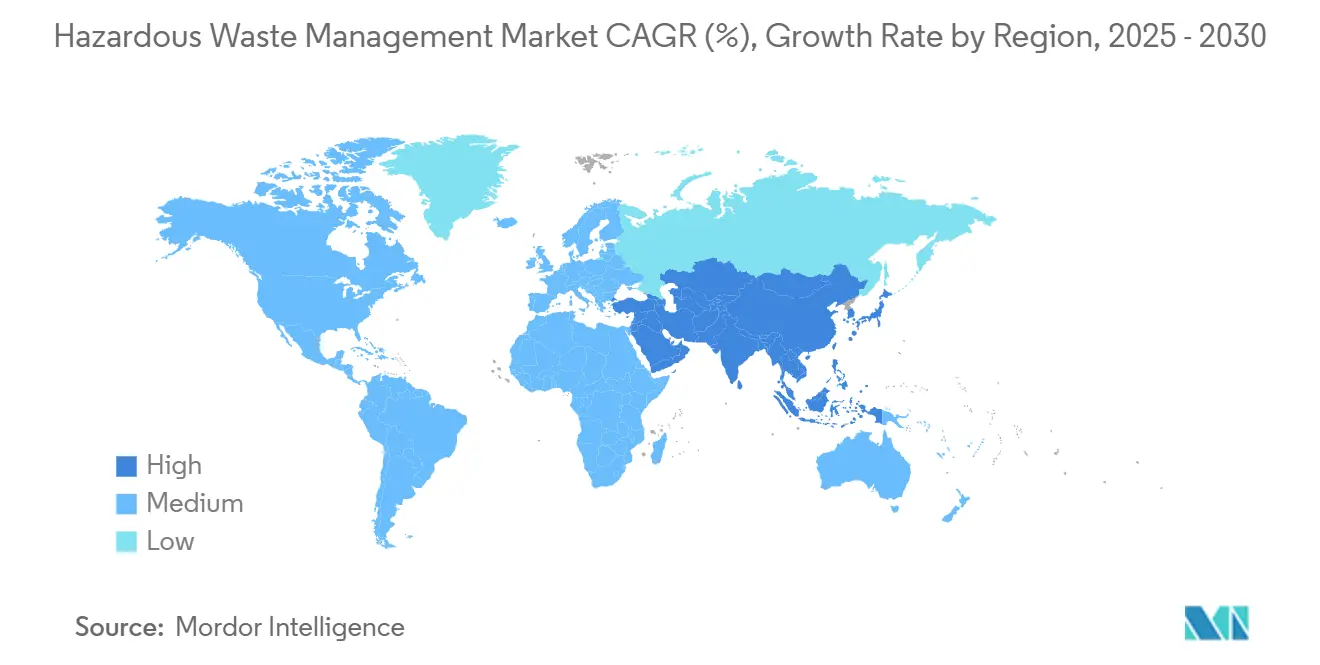
Note: Segment shares of all individual regions available upon report purchase
Competitive Landscape
The Hazardous Waste Management Market is moderately concentrated. Industry consolidation is advancing as vertically integrated leaders seek economies of scope. Waste Management’s USD 7 billion acquisition of Stericycle broadens its medical-waste footprint and aggregates transport capacity, signaling that scale remains a defensive moat. Similarly, Veolia’s GreenUp program allocates multi-billion-dollar capex for hazardous waste plant upgrades and AI-enabled control rooms to lift material recovery rates.
Technology leadership is now a core differentiator. General Atomics' EPA-validated iSCWO unit provides 99.99% PFAS destruction, positioning early adopters for regulatory-driven premium pricing. Clean Harbors’ Total PFAS Solutions targets the same niche with proprietary sorbents. Smaller disruptors, such as 374Water's modular AirSCWO skids, enable decentralized treatment for municipal clients.
Geographic expansion strategies favour Asia-Pacific hubs and Middle East decommissioning corridors. Western majors partner with local incumbents such as Veolia’s ADQ alliance, securing regulatory clearance and feedstock certainty. Digital-platform entrants leverage blockchain to win European traceability tenders, carving data-centric profit pools. Competitive intensity therefore pivots on both asset scale and digital acumen across the hazardous waste management market.
Hazardous Waste Management Industry Leaders
-
Veolia Environnement SA
-
Waste Management Inc.
-
Clean Harbors Inc.
-
Suez SA
-
Republic Services Inc.
- *Disclaimer: Major Players sorted in no particular order
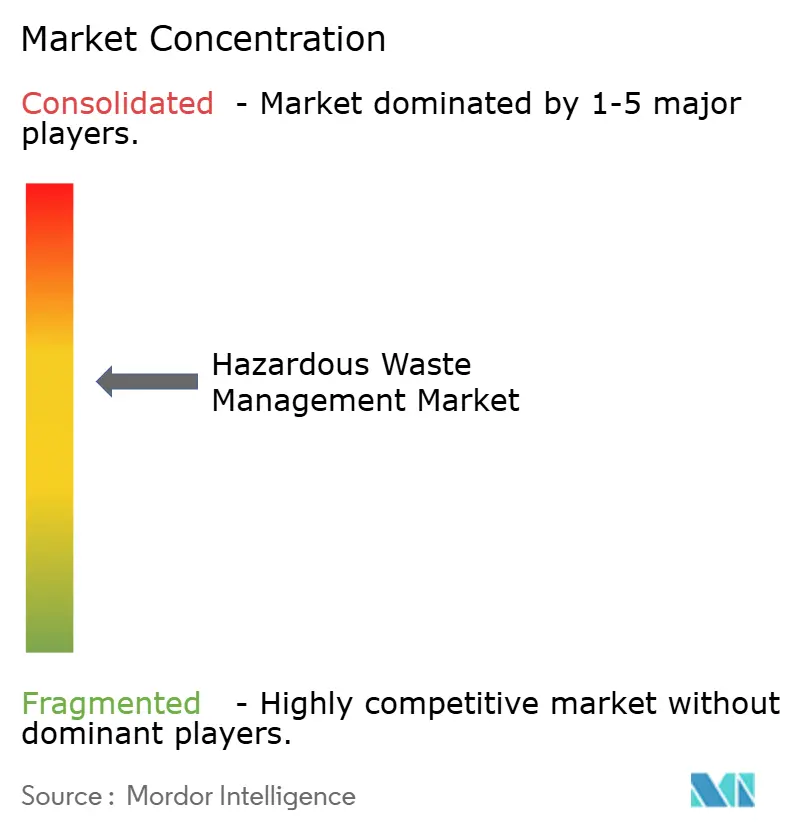
Recent Industry Developments
- January 2025: General Atomics began demonstrating its industrial SCWO system at Clean Earth’s North Carolina site under a Department of Defense contract, achieving 99.99% PFAS destruction efficiency.
- October 2024: Veolia North America unveiled a high-temperature thermal plant, solar array, and reforestation program at its Arkansas hazardous-waste campus.
- May 2024: The EU implemented a new Waste Shipments Regulation, mandating digital tracking and tighter export controls to non-OECD countries.
- March 2024: The US EPA directed USD 3.5 billion to Superfund and USD 1.5 billion to Brownfields clean-up, prioritising resource recovery.
Research Methodology Framework and Report Scope
Market Definitions and Key Coverage
Our study defines the hazardous waste management market as the worldwide revenue earned when regulated wastes that are toxic, flammable, corrosive, reactive, infectious, or radioactive are collected, stored, transported, treated, disposed of, or recycled through secure facilities. It tracks solid, liquid, and sludge streams handled by collection fleets, transfer stations, physico-chemical plants, high-temperature incinerators, biotreatment units, energy-recovery kilns, and engineered landfills.
Scope exclusion: routine municipal solid waste and inert construction debris that fall outside hazardous classifications are not counted.
Segmentation Overview
- By Physical State
- Solid
- Liquid
- Sludge
- By Waste Category
- Chemical Waste (Industrial)
- E-Waste (batteries, etc)
- Biomedical / Clinical Waste
- Radioactive Waste
- Others (Flammable & Explosive Waste, Corrosive & Oxidising Waste)
- By Treatment/ Disposal Method
- Physico-Chemical Treatment (Neutralisation, Precipitation, Stabilisation, Solidification, Oxidation, etc)
- Thermal Treatment (Incineration, Plasma Arc, Pyrolysis)
- Biological Treatment (Anaerobic, Composting)
- Landfill
- Recycling & Resource Recovery
- Others (Encapsulation, Deep-Well, etc)
- By Service
- Collection & Transportation
- On-site Storage
- Treatment & Disposal
- Consulting, Audit & Training
- By Industry
- Oil & Gas
- Chemical & Petrochemical Manufacturing
- Healthcare & Pharmaceuticals
- Mining & Metallurgy
- Power Generation (Coal, Nuclear)
- Construction & Demolition
- Automotive & General Manufacturing
- Electronics & E-waste Recycling
- Others (marine, municipal, agriculture, etc.)
- By Geography
- North America
- United States
- Canada
- Mexico
- South America
- Brazil
- Argentina
- Rest of South America
- Asia-Pacific
- China
- India
- Japan
- South Korea
- ASEAN (Indonesia, Thailand, Philippines, Malaysia, Vietnam)
- Australia
- Rest of Asia-Pacific
- Europe
- Germany
- United Kingdom
- France
- Italy
- Spain
- BENELUX (Belgium, Netherlands, and Luxembourg)
- NORDICS (Denmark, Finland, Iceland, Norway, and Sweden)
- Rest of Europe
- Middle East & Africa
- Saudi Arabia
- United Arab Emirates
- Qatar
- Turkey
- South Africa
- Nigeria
- Egypt
- Rest of Middle East and Africa
- North America
Detailed Research Methodology and Data Validation
Primary Research
Fortnightly calls and structured surveys with regulators, treatment operators, fleet managers, and industrial EHS heads in North America, Europe, China, India, and the Gulf validated pricing bands, capacity use, and planned regulation, which sharpened assumptions that literature alone could not resolve.
Desk Research
We began with open data from the US EPA, Eurostat, the Basel Convention shipment database, OECD Environment Statistics, and the World Bank, and then broadened coverage to trade-body bulletins such as ISWA and national environment ministries. Regulatory filings, company 10-Ks, investor decks, patent archives, and respected science journals filled technical gaps. To profile financials and news, we accessed D&B Hoovers and Dow Jones Factiva, and this list is illustrative and supplemented by several other sources that informed data checks and context.
Market-Sizing & Forecasting
We rebuilt the 2025 baseline top-down: country hazardous waste arisings (tons) were multiplied by average compliant handling charges and adjusted for cross-border trade. Bottom-up spot checks on operator revenue, tender values, and sampled ASP × volume pairs anchored the totals. Key inputs include industrial production, battery and pharmaceutical output, incinerator capacity additions, fee escalation indices, and shipment permit data. A multivariate regression, stress tested through scenario analysis, projects demand to 2030, while gaps in low-visibility regions are bridged with calibrated proxy ratios from comparable economies.
Data Validation & Update Cycle
Outputs pass two analyst reviews; variance thresholds trigger re-contact with sources, and models refresh each year, with mid-cycle updates when material policy or capacity shifts occur.
Why Mordor's Hazardous Waste Management Baseline Earns Decision Maker Trust
Published estimates often diverge because firms slice the market differently and apply uneven refresh rates.
Key gap drivers include narrower service coverage, exclusion of trade flows, and static fee assumptions used by some publishers, whereas we report the full cradle to grave value chain and update annually.
Benchmark comparison
| Market Size | Anonymized source | Primary gap driver |
|---|---|---|
| USD 52.94 bn (2025) | Mordor Intelligence | Baseline |
| USD 17.64 bn (2024) | Global Consultancy A | Counts treatment only and omits collection plus advisory revenue |
| USD 41.56 bn (2024) | Regional Consultancy B | Uses static ASPs and ignores cross-border waste exports |
These contrasts show that Mordor analysts deliver a balanced, transparent baseline tied to clear variables and repeatable steps, giving stakeholders a figure they can rely on.
Key Questions Answered in the Report
What is the current size of the hazardous waste management market?
The market is valued at USD 52.94 billion in 2025 and is expected to reach USD 72.66 billion by 2030.
Which region holds the largest share of the hazardous waste management market?
Asia-Pacific leads with 40.24% of 2024 revenue and also posts the fastest 6.8% CAGR to 2030.
Which treatment method is growing fastest?
Recycling and resource-recovery services are expanding at a 10.9% CAGR, driven by circular-economy mandates.
Why are supercritical water oxidation systems gaining attention?
They achieve 99.99% destruction of PFAS and other persistent pollutants, meeting new regulatory bans on incineration.
How is the oil and gas sector influencing market growth?
Extensive decommissioning programmes generate large sludge volumes, keeping oil and gas the leading industry segment with 26% revenue share.
What major acquisition affected the competitive landscape recently?
Waste Management’s USD 7 billion purchase of Stericycle created the largest single transaction in the sector and broadened its medical-waste reach.
Page last updated on:
